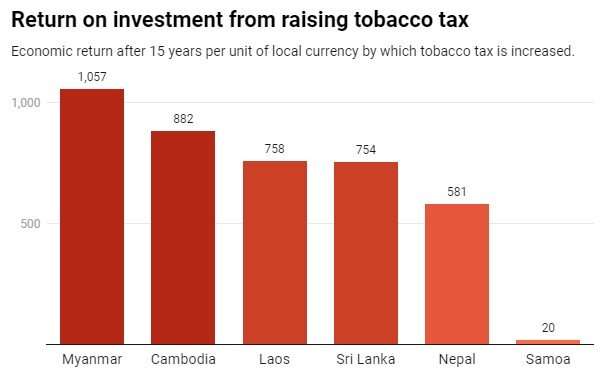
The human costs of tobacco and smoking worldwide are huge. 1.3 billion people use tobacco, mostly in low- and middle-income countries. More than 8 million people die prematurely because of tobacco, at an annual economic loss of at least US$1.4 trillion. And you don’t have to be a smoker to be harmed: secondhand smoke exposure kills nearly 400,000 women every year.
Asia is home to seven of the world’s top 10 countries with the highest number of smokers: Bangladesh, China, India, Indonesia, Japan, the Philippines, and Viet Nam. Yet, according to our recent research for the United Nations Development Programme, not enough being done to reduce tobacco’s harms.
That’s why it’s worth pointing out a solution that really works, yet not enough Asian nations have acted on it: raising tobacco prices through higher taxes.
As the Philippines, Australia and Aotearoa New Zealand have shown, doing that—coupled with other policy changes—can make a real difference.
The pay-off for higher taxes
Increasing tobacco taxes costs relatively little, but yields a high impact.
In our study of six Asia-Pacific countries, we found that for every unit of local currency invested in increasing tobacco taxes, the countries would gain between 20 and 1,057 units in return over 15 years. That’s a remarkable return on investment ratio of between 20:1 and 1,057:1.
One direct benefit is a substantial increase in government revenue. In Cambodia alone, the projected additional government revenue would be US$230 million over five years from the recommended levels of tobacco tax increases.
And it would be pro-poor, pro-development, and pro-women.
Who would benefit most?
Smoking is responsible for nearly half of the difference in death rates between wealthy and poor people, meaning measures that reduce smoking disproportionately benefit poor people.
People with low incomes—both men and women—are more likely to use tobacco than their wealthier counterparts. In Myanmar, for example, 41% of men and 4% of women in the lowest income group smoke, compared with 25% of men and 0.4% of women in the highest group.
It is true that tax increases initially make the low earners who don’t cut back worse off, but over time the health gains to low earners become more important.
Although the reductions in smoking-related deaths from higher taxes are concentrated in men, the financial benefits appear to flow to women.
As smokers quit, household budgets become easier, facilitating what a study in the British Medical Journal describes as an income transfer from male smokers to females and other family members.
Lower smoking rates also protect female non-smokers from exposure to second-hand smoke at home and work.
How the Philippines became an Asia-Pacific leader
In the Philippines, half of the excise tax collected from tobacco products and sugar-sweetened beverages, and 80% of the excise tax collected from alcohol and vaping products is used to fund healthcare services.
The remaining 20% of alcohol and vaping excise revenue is allocated to social development, while 5% of tobacco excise tax revenue is earmarked to support tobacco farmers, including to help them switch crops.
Among its many reforms, the Philippines also instituted a whole-of-public sector code of conduct to prevent tobacco industry interference in its public policymaking.
Between 2012 and 2015, substantial tax increases in the Philippines cut cigarette sales by 28% and cut the number smokers by 3 million, with the largest reductions among the poorest parts of the population.

Yet despite the Philippines’ example and the clear benefits of significant tobacco tax increases, tobacco tax rates in most low income countries remain low. On average, tax accounts for only 19% of the retail price of cigarettes in low-income countries, compared to 51% in high-income countries.
Higher taxes, fewer smokers in Australia & NZ
Among other Asia-Pacific nations, Australia’s rate of tobacco excise has climbed from 19 cents per cigarette in 1999 to A$1.16, and will climb again by 5% per year for each of the next three years in addition to normal indexation.
Over that time the proportion of Australians aged 14 and over who smoke daily has plummeted from 22% to 11%. The Australian government says it wants to get it below 10% by 2025 and to 5% by 2030.
Aotearoa New Zealand has gone even further with its “Smokefree 2025” policy, with a goal that by 2025, fewer than 5% of New Zealanders will be smokers. This strategy includes banning the sale of tobacco products to anyone born after Jan 1, 2009.
The NZ government increased the tobacco excise tax by inflation plus 10% each year between 2010 and 2020. Decades of efforts in tobacco control, including tobacco taxation, have resulted in smoking rates declining from 36% in 1976 to 13% in 2020.
Even smokers back higher tax—if it goes to health
Higher taxes on cigarettes are overwhelmingly supported by non-smokers.
But a US study has found that when the extra tax revenue is directed to healthcare programs, they are also overwhelmingly supported by smokers: 60% of those surveyed, up from 25% if the extra revenue is unallocated.
The tax gap between rich and poorer countries might be partly due to myths such as that increasing tobacco taxes
- disproportionately hurts poor people,
-
leads to massive job losses, and
-
substantially diminishes government revenue.
Our policy brief debunks these myths with evidence.
Economic stress is brewing in many Asia-Pacific countries, with many under unprecedented pressure from stagnating revenue and growing needs for spending on health, education and social protection.
The United Nations’ Human Development Index has declined for two consecutive years for the first time since data became available.
These extraordinary circumstances offer an extraordinary opportunity to act decisively. Taxation on tobacco and other harmful products should be one of them.
Journal information:
British Medical Journal (BMJ)

Source: Read Full Article
